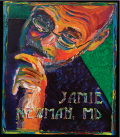Morpheus
For thousands of years, ancient civilizations in Asia Minor have been cultivating the opium poppy.
A man lies writhing in pain; he is futilely searching for a comfortable position. His doctors walk into the room and speak at length about his failing kidneys and his damaged liver. He does not hear a word. All he can focus on is his 11/10 pain and his pain medication. He has a history of drug abuse, and the team is trying to balance his suffering and his addiction. From the patient's perspective, mitigation of that pain, whether physical or psychological, takes precedence over meaningless terms like “creatinine” or “transaminase.”
The nurse brings in a cup with two small round tablets, thousands of years in the making. Regulated, bar-coded and documented, these small pills are the latest iteration of a tale starting with the first cultivation of Papaver somniferum, the opium poppy. With one swift gulp, the man joins millennia of his forbearers in the arms of Morpheus.

For thousands of years, ancient civilizations in Asia Minor have been cultivating the opium poppy. The Sumerians, a powerful civilization located in present day Iraq, referred to it as hul gil, or the “plant of joy.” Opium cultivation spread through the western Mediterranean, where the Greek term opos, or juice, ultimately came to describe the sap of the poppy plant. In the Greek epic “The Odyssey” by Homer, Helen “cast a drug into the wine to lull all pain and anger and bring forgetfulness of every sorrow”; some scholars believe this referred to opium. By the end of the first millennium, opium was known throughout the Old World both for its medicinal effects and its recreational pleasures.
Dioscorides, author of the great Greek “Materia Medica,” described the distinction between the juice and the whole plant, the technique for harvest, and a method for making a syrup from poppies. The famous Arabic physician known in the west as Avicenna recommended the syrup especially for diarrhea. In the 15th century, the odd historical figure Paracelsus coined the term “laudanum.” One variety of the laudanum of Paracelsus was one-quarter opium, with the exotic additions of henbane, bezoar stone, and mummy! Laudanum elixir (minus the mummy) became a very common method of administration.
In the early 19th century, in the small German town of Paderborn, an apothecary's assistant by the name of Friedrich Sertürner isolated an alkaline substance from laudanum. The substance was so adept at inducing sleep that Sertürner ultimately named the substance after the Greek god of sleep, Morpheus. Morphine, as it was eventually called, was praised for its long-lasting analgesic and soporific properties.
In 1843, a Scottish physician, Dr. Alexander Wood, devised the morphine hypodermic syringe. The medical myth is that his wife, Rebecca Massey, became the first IV narcotic addict. Whether this is true or not, it certainly happened to many other patients. Opium was addictive, and the stronger narcotics were more so than their progenitors. During the Civil War in the United States, morphine addiction became known as “soldier's disease” after many soldiers who required morphine for injuries and amputations ended up as lifetime addicts.
The number of alkaloid derivatives grew, including “codein” in 1832. First synthesized in 1874 by British scientist C.R. Wright and commercialized in 1895 by Bayer Pharmaceuticals, another new alkaloid was discovered that promised to be more potent than morphine but without the addictive side effects. It was even embraced as a potential cure for morphine addiction. Such great expectations were had for this drug that it was named after the German word heroisch, or heroic. But like its predecessor, heroin proved to be extremely addictive.
In the first half of the 20th century, eager to maximize analgesic potency while minimizing addictive potential, biochemists synthesized many opiates, from codeine derivatives like oxycodone to morphine derivatives like hydromorphone.
Since then, opiate prescriptions in the U.S. have skyrocketed. Despite having less than 5% of the world's population, the U.S. consumes nearly 80% of the world's opioid supply. The number of Americans suffering from addiction and dying from overdose due to prescription opiate use is growing at an alarming rate. Addiction and its social and physical consequences present an enormous challenge to the American public and its health care system.
Throughout history, the use of opiates has been in a delicate balance. When the drugs are used too sparingly, patients suffer physical pain. When they are promoted too liberally, patients may suffer the devastation of addiction. Pain should never be discounted, but opiates are never the only solution for pain management.
Hours later, when the team returned to the patient's room for afternoon rounds, they found him much more relaxed. A discussion about his kidneys and liver ensued, and a plan was made. As the team walked out the door, he reminded them not to forget to order his evening dosage.



